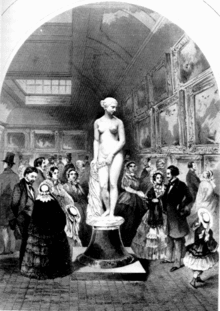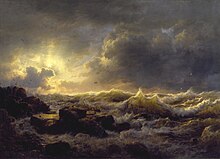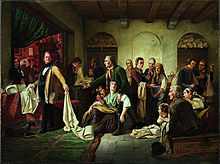Düsseldorf Gallery

The Düsseldorf Gallery was a gallery on Broadway in New York City and in the Boston Athenæum . It existed from 1849 to 1861 and served the exhibition and sale of pictures from the Düsseldorf School of Painting in the United States . As a permanent institution, it took a central place in the art metropolis of New York. Your name corresponds in English with that of the historical Gemäldegalerie Düsseldorf .
history
On April 18, 1849, the German-American Johann Gottfried Böker (also John Godfrey Boeker , 1794 / 1795–1860), a German-American born in Remscheid , opened a wine and spirits dealer from New York City, who temporarily served as the American consul in Elberfeld (for the Rhine Province and Westphalia ) and as US Consul General in Basel (for Switzerland had worked), in a house on Broadway no. 548, a hall for art trade . The hall was on the Broadway section between the cross streets of Spring Street and Prince Street, "above the Church of the Divine Unity , a converted neo-Gothic building that the Unitarian Congregation had erected in 1845". The gallery's opening hours were usually between 10 a.m. and 10 p.m. Around 150 works from the Düsseldorf School of Painting were exhibited in it, which Böker - a member of the Art Association for the Rhineland and Westphalia since 1829, and its committee member since 1846 - had collected privately. In order to ensure adequate lighting in the evenings, Böker had gas lighting installed, an innovation allegedly no other retailer in the city had used before. A visitor paid a quarter of a dollar as entrance fee. In addition to Böker's twenty-year-old picture collection, which was later claimed to have cost him $ 230,000 to acquire, several pictures were added each year, while individual picture sales reduced the collection again. From April to December 1852 Bökers' gallery moved to Boston , where he had rented rooms in the Athenæum . In 1854 the gallery moved to the building on Broadway No. 497, the seat of the American Art Union, which was dissolved in 1852 . As the business is no longer particularly went well, he sold the entire inventory Gallery in 1857 at the Cosmopolitan Art Association in Sandusky (Ohio) for $ 180,000. However, this arrangement did not last. In 1859 the Düsseldorf Gallery was mentioned again as an independent institution. With the inclusion of American works and the Jarves Collection of Old Masters and the Italian School in 1860, the original exhibition concept finally changed. The location of the Düsseldorf Gallery also changed again. Along with the other attractions, it was promoted by the Institute of Fine Arts on 625 Broadway. In 1861, the outbreak of the Civil War also ended the exhibition. On December 18, 1862, the Düsseldorf Gallery's collection, which ultimately comprised 107 pictures, was auctioned off. It is said to have generated total proceeds of $ 45,000.
Bökers exhibition




The original exhibition essentially comprised pictures from his own collection, which Böker had transferred to New York before the events of the German Revolution of 1848/1849 , including The Düsseldorf Artists' Bird Shooting in the Grafenberger Wald (1844), a joint picture by Friedrich Boser and Carl Friedrich Lessing . In May 1849, he unsuccessfully asked the Städtische Gemäldegalerie Düsseldorf to provide the pictures The Hardangerfjord ( Andreas Achenbach , 1843), The Devotion of the Haugians ( Adolph Tidemand , 1848) and The Siege (Carl Friedrich Lessing, 1848). In 1850 he expanded his collection by 15 oil paintings and around 35 drawings, in 1851 by 17 new acquisitions, mainly landscapes, as well as the historical picture Johann Hus in front of the funeral pyre 1415 (Carl Friedrich Lessing, 1850), which was a major work of the exhibition. High customs regulations led Böker to appeal to the Düsseldorf artists in 1851 not to send their works to America anymore. Therefore the gallery remained primarily a permanent collection in the following period.
Several artists were represented in the exhibition several times, Carl Wilhelm Hübner and Johann Peter Hasenclever with seven works each, Andreas Achenbach with four landscapes and six drawings, including the storm on the coast of Sicily , Theodor Hildebrandt with five works, two of which were versions of Orthello and Desdemona , Carl Friedrich Lessing with four pictures, Hans Fredrik Gude with four landscapes and Wilhelm Camphausen with four history paintings . By Emanuel Leutze two loans were in the Dusseldorf Gallery issued from an American private collection, the Puritans, who surprised his daughter in front of a picture of the Madonna and Henry VIII. And Anne Boleyn in the park . Even Christian Koehler Waking Germania found its way into Bökers exhibition. There it became one of the most admired and influential paintings in the gallery's history. Other artists who were represented in the Düsseldorf Gallery until 1851 are Oswald Achenbach , Jakob Becker , Clemens Bewer , Gustav Jacob Canton , Carl Clasen , Lorenz Clasen , Carl Ferdinand Dahl , Ernst Deger , Jakob Fürchtegott Dielmann , Carl Gottfried Eybe , Otto Grashof , Eugene von Guerard , Carl Hilgers , Elisabeth Jerichau-Baumann , Rudolf Jordan , Wilhelm Klein (1821–1897), Siegmund Lachenwitz , Julius Lange , Jakob Lehnen , August Leu , Friedrich August de Leuw , Johann Wilhelm Lindlar , Simon Meister , Theodor Mintrop , Andreas Müller , Karl Müller , George Jacobus Johannes van Os , Hermann Plüddemann , Eduard Wilhelm Pose , Johann Wilhelm Preyer , Gottfried Pulian , Georg Saal , Caspar Scheuren , Johann Wilhelm Schirmer , Adolph Schroedter , Arnold Schulten , Friedrich Simmler , Karl Ferdinand Sohn , Johann Baptist Sonderland , Eduard Steinbrück , Hermann Steinfurth , Adolph Tidemand, Wilhelm Volkhart , August Weber and Edmund Wodick .
reception
The opening of the gallery was a success. The New York Weekly Evening Post praised the fact that "there is not a single picture that has not earned merit". The Home Journal wrote: “The Düsseldorf collection is of unusual grandeur in the field of art. Because it is the sudden and unprepared discovery of an entire school of painting, of whose existence we previously knew little or nothing. " The Fine Arts magazine assessed that this German school of painting, because of its formal perfection, the security of composition, The greatness of the pictorial idea and, ultimately, the ability of artists to commune, should be preferred to French and English painting. The Bulletin of the American Art Union called the exhibition "one of the most enjoyable and instructive collections that has ever been seen in the United States." The Düsseldorf Gallery will thus be a moment for young American artists to train instead of on the Tiber to walk the Rhine.
Since the gallery was also suitable as a secret meeting place for lovers because of the areas screened off by partition walls, its nickname was soon called “the Lovers' Tryst” (“the love rendezvous”). The artist Elihu Vedder said ironically that this fact, which distracted him from art, explains why he was not more strongly influenced by the Düsseldorf School of Painting. Although at least forty Americans studied painting in Düsseldorf between 1840 and 1860, the Düsseldorf Gallery was probably not that popular among New York artists. Worthington Whittredge , himself a painter from the Düsseldorf School and later President of the National Academy of Design for a few years , found that art critics were right to criticize many of the works exhibited there because of their “hard” German style and their lack of color, their studio tone. When the art critic and painter John Durand (1822–1908) looked back in 1894 on the effects of the gallery on the United States, he said that one could say that at the time the Düsseldorf Gallery was founded there was an eclipse of American art (“eclipse of American art ") Occurred. The Düsseldorf school had no prestige and the gallery's audience was neither intellectually nor financially prepared for it. Some would even have believed that the owner of the gallery or the author of their pictures was a “Mr. Dusseldorf ”. All that it meant “for us” was the appearance of foreign art in large numbers. This statement suggests that the US art market in the mid-19th century was “flooded” by European art, especially from Düsseldorf, to the detriment of local artists.
literature
- Raymond L. Stehle: The Düsseldorf Gallery of New York . In: New-York Historical Society Quarterly , 58 (October 1974), pp. 305-314 ( digitized ).
- William H. Gerdts : The "Düsseldorf Gallery". “The Düsseldorf painting collection formed an era of American art” . In: Katharina Bott, Gerhard Bott (ed.): ViceVersa. German painters in America, American painters in Germany 1813–1913 . Exhibition catalog, Deutsches Historisches Museum Berlin, Munich 1996, pp. 44–61.
- William H. Gerdts: "Good Tidings of the Lovers of the Beautiful". New York's Düsseldorf Gallery, 1849–1862. In: American Art Journal , 30 (1999), nos. 1-2, p. 51.
- Sabine Morgen: The impact of the Düsseldorf school in America in the 19th century. Düsseldorf paintings in America and American painters in Düsseldorf . Göttingen Contributions to Art History, Volume 2, Edition Ruprecht, Göttingen 2008, ISBN 978-3-76753-059-1 , p. 265 f. ( Reading sample , table of contents as PDF ).
Web links
- Düsseldorf Gallery (New York, NY) , data sheet in the worldcat.org portal
Individual evidence
- ↑ Bettina Baumgärtel : About the project . In: Bettina Baumgärtel (Hrsg.): The Düsseldorf School of Painting and its international impact 1819–1918 . Michael Imhof Verlag, Petersberg 2011, ISBN 978-3-86568-702-9 , Volume 1, p. 19 (Figure 5)
- ↑ Sabine Morgen, p. 265 f.
- ↑ Horst Heidermann : We have the pictures! Heinrich Christoph Kolbe in Wuppertal . In: Geschichte in Wuppertal , Jg. 16 (2007), p. 47 ( PDF ( Memento of the original from March 4, 2016 in the Internet Archive ) Info: The archive link has been inserted automatically and has not yet been checked. Please check the original and archive link accordingly Instructions and then remove this notice. )
- ↑ Malcolm Goldstein: Landscape with Figures. A History of Art Dealing in the United States . Oxford University Press, New York / NY 2000, ISBN 0-19-513673-X , pp. 27 f. ( Google Books )
- ^ Broadway in 1851 , reprint of Doggett's New York City Street Directory, for 1851 . W. Worden, New York 1878 ( digitized version )
- ↑ Peter Collister (Ed.): A Small Boy and Others. Henry James. A Critical Edition . University of Virginia Press, Charlottesville / London 2011, ISBN 978-0-8139-3082-4 , p. 206, footnote 433 ( Google Books )
- ^ Sabine Morgen: The broadcast of the Düsseldorf painting school to America . In: Bettina Baumgärtel (Ed.), Volume 1, p. 187 and footnote 1
- ^ Worthington Whittredge - Cf. Gabriele Ewenz (arr.): Sources for the Düsseldorfer Malerschule 1825–1928 . In: Bettina Baumgärtel (Ed.), Volume 1, p. 411
- ↑ Stephen L. Dyson: The Last Amateur. The Life of William J. Stillman . State University of New York, Albany / New York 2014, ISBN 978-1-4384-5261-6 , p. 29
- ^ The Evening Post , New York, April 25, 27 and May 4, 1854 issues
- ^ Sabine Morgen: The broadcast of the Düsseldorf painting school to America . In: Bettina Baumgärtel (Ed.), Volume 1, p. 189
- ^ Winifred E. Howe: A History of the Metropolitan Museum of Art . The Metropolitan Museum of Art, New York 1913, p. 86 ff. ( Google Books )
- ^ Bettina Baumgärtel: Friedrich Boser: The picture show of the Düsseldorf artists in the gallery hall . In: Bettina Baumgärtel (Ed.), Volume 2, p. 37 (Catalog No. 18)
- ^ Kathrin DuBois: Carl Wilhelm Hübner: The Silesian Weavers, 1844 . In: Bettina Baumgärtel (Ed.), Volume 2, p. 305 (Catalog No. 255)
- ^ Sabine Morgen: The broadcast of the Düsseldorf painting school to America . In: Bettina Baumgärtel (Ed.), Volume 1, pp. 187 ff.
- ^ William H. Gerdts, pp. 56, 62
- ↑ Cf. Catalog of a Private Collection of Paintings and Original Drawings by Artists of the Düsseldorf Academy of Fine Arts . Wm. C. Bryant, New York 1851 ( digitized version )
- ^ The New York Evening Post . Issued May 3, 1949
- ^ Bettina Baumgärtel: The Düsseldorf School of Painting and its international charisma . In: Bettina Baumgärtel (Ed.), Volume 1, p. 40
- ^ Wend von Kalnein : The influence of Düsseldorf on painting outside Germany . In: Wend von Kalnein (Ed.): The Düsseldorf School of Painting . Verlag Philipp von Zabern, Mainz 1979, ISBN 3-8053-0409-9 , p. 202
- ^ Elihu Vedder : The Digressions of V. Houghton, Mifflin, Boston 1910, pp. 105 f.
- ↑ Malcolm Goldstein, p. 27 f.
- ↑ John IH Baur (ed.): The Autobiography of Worthington Whittredge 1820-1910 . In: Brooklyn Museum Journal , 1942, p. 24 ( digitized version )
- ↑ Gabriele Ewenz (arrangement): Sources for the Düsseldorf School of Painting 1825–1928 . In: Bettina Baumgärtel (Ed.), Volume 1, p. 411
- ^ John Durand: Life and Times of AB Durand . Charles Scribner's Sons, New York 1894, p. 193 ( digitized version )


